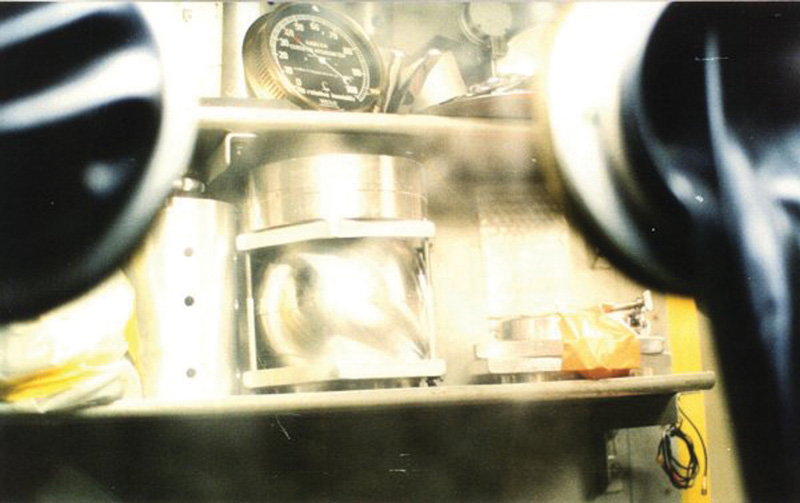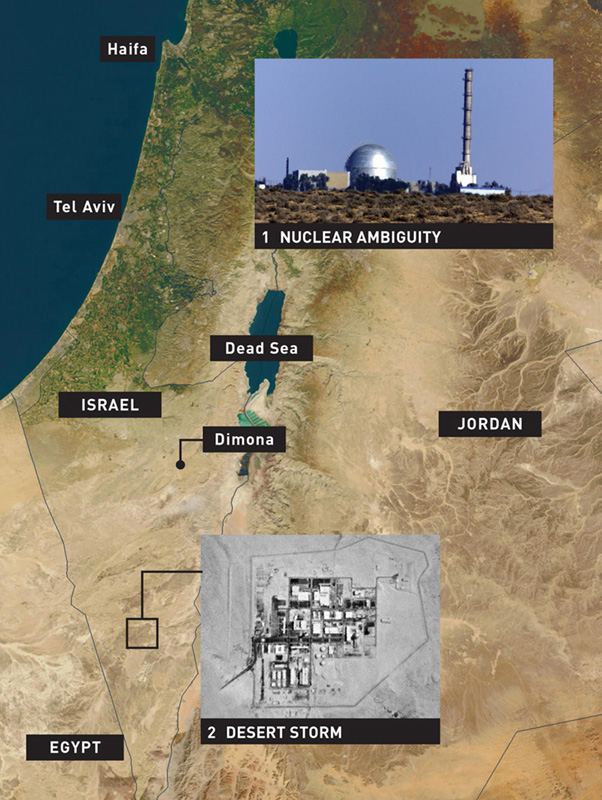
65 Negev Nuclear Research Center
LOCATION Negev Desert, southern Israel
NEAREST POPULATION HUB Dimona
SECRECY OVERVIEW Operations classified: center of Israel’s nuclear weapons development program.
While the government in Tel Aviv acknowledges the existence of an installation in the Negev Desert, it maintains silence on its exact purpose. Nonetheless, there is widespread speculation that this is the heart of Israel’s nuclear project—an initiative that has prompted the International Atomic Energy Agency (IAEA) to express concerns about nuclear proliferation in the Middle East.
Israel itself operates a policy of “nuclear ambiguity,” whereby the question of whether the country has nuclear weapons is never officially confirmed or denied. Instead, since 1965 the country has stated that it will “not be the first” country to introduce weapons to the Middle East—a line that is open to disparate interpretations. It is one of four nations (along with India, North Korea and Pakistan) believed or known to have nuclear capabilities but who are not signatories to the Nuclear Non-Proliferation Treaty.
According to the Israel Atomic Energy Commission, the work undertaken at Negev is to “broaden basic knowledge in nuclear sciences and adjacent fields and to provide the foundation of the practical and economic utilization of nuclear energy.” Construction of the research center began in secret in 1958, with French assistance. As many as 1,500 Israelis were employed in building it at any one time, and it is alleged that an Office of Science Liaisons was established in Israel specifically to provide the enterprise with security and intelligence. The facility became operational at the end of 1963.
However, the West became aware of Negev as early as 1960 in a series of opaque and then gradually more explicit newspaper revelations. The news prompted Israeli Prime Minister David Ben-Gurion to claim that Negev was a facility dedicated to “peaceful purposes.” However, the chairman of the Israel Atomic Energy Commission was later quoted as saying: “There is no distinction between nuclear energy for peaceful purposes or warlike ones.”
US inspectors made several visits to Negev over the course of the 1960s, although the Israeli authorities demanded prior warning of their arrival. While these inspections failed to uncover evidence of weapons-related activity (which some have alleged was as a result of Israeli obstruction), other intelligence had led the US to conclude by the end of the decade that Israel might well be in possession of the bomb.
Confirmation of these rumors apparently came in 1986, when a former Negev nuclear engineer named Mordechai Vanunu defected from Israel and traveled to the UK. Vanunu had worked at Negev since 1977 but harbored severe doubts about several aspects of Israeli foreign policy. He lost his job at Negev in 1985, whereupon he undertook a period of travel, during which he met a journalist who acted as his agent in a deal with the Sunday Times newspaper. Vanunu revealed what he knew about Negev, backed up with photographs he had secretly taken. His evidence, considered credible by numerous experts, led to an estimate that the Israeli arsenal consisted of over 100 weapons.

INCENDIARY IMAGES This photograph was taken in 1985 by Mordechai Vanunu, allegedly showing components to be used in Israel’s nuclear weapons program. Vanunu came to the West to blow the whistle on what he had seen at Negev, turning his own life upside-down in the process.
What followed was a storyline worthy of any movie. Mossad, Israel’s secret service, employed a female agent to pose as an American and befriend Vanunu, who was rumored to be lonely away from his homeland. The agent persuaded Vanunu to accompany her on a holiday to Rome. Once settled in the Eternal City, three more Mossad agents arrived on the scene, drugged their quarry and smuggled him back to Israel. There, he was tried for treason and espionage and sentenced to 18 years in prison. In 2004 Vanunu would make entirely unproven claims that Israel had been complicit in the assassination of President John F. Kennedy as a result of Washington’s demands for information on Negev.
Most of Negev’s facilities are built underground, purportedly to a depth of six floors. The airspace above the base is closed to aircraft, with Israeli Air Force jets on standby to scramble in the event of a breach. It is also rumored that a battery of anti-aircraft missile launchers are in operation around the site. Existing security measures on the ground (including fences and a heavy presence of guards) were supplemented with additional cutting-edge cameras and surveillance equipment following a security review in late 2011.
Mystery continues to surround Negev, with varying estimates as to the quantity of plutonium that it is capable of producing. This has led to wildly differing guesses as to how many nuclear weapons now comprise Israel’s arsenal. In early 2012, it was reported in the Western media that Negev may close as Israel seeks to safeguard its assets in the event of an Iranian air strike. The story, however, was denied by an Israeli official.

1 NUCLEAR AMBIGUITY A ground-level view of the complex near Dimona, taken around 2000. While Tel Aviv continues its policy of neither confirming nor denying possessing the bomb, fears grow that Iran may join Israel as a regional nuclear power.
2 DESERT STORM An overhead view of the controversial complex at Negev, taken by an American strategic reconnaissance satellite—Corona KH-4—in November 1968. Such images left Washington to conclude that Tel Aviv was indeed in possession of the bomb.